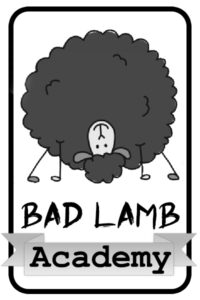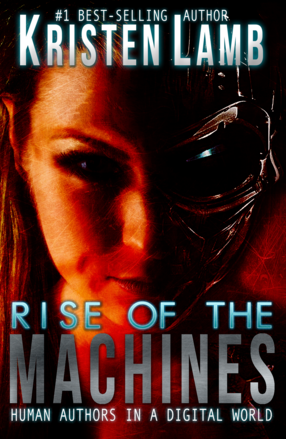It might remind you of the movie Groundhog Day: Yes, it’s true, Alex Limberg is here with us once again. Like all that glitter that fell off your Christmas decorations? Can’t get rid of him. To mix things up a bit, Alex is assisting me through the holiday season. Also, his free ebook “44 Key Questions” to test your story will help you with creating intriguing stories. This time he puts on his action hat and shares a clever recipe to write your readers’ socks off with action scenes. Let’s get right to it.
***
BOOM! CRASH! BANG!
It’s Batman chasing Superman through James Bond’s porcelain collection. Broken glass, bones and promises everywhere.
But here’s the problem: It reads like an academic lecture about 17th century German philosophy.
If the style can’t convey your action in an edgy and dramatic way, even the most wicked scene structure won’t help. You are a writer, thus you need to get under your readers’ skin with your words.
When you hear “action scene,” what comes to your mind first?
It’s probably a movie and not a book, because movies are the ideal medium for action: Graphic, supported by audio and all kinds of (special) effects, easily creating pace with cuts, and the audience can save themselves the effort of active reading.
So if your story contains a fast-paced action scene, you want it to play out in your reader’s head just like a movie: High speed, quick cuts, graphic images, lots of tension.
Here are some techniques to give your reader a fast, exciting, high-octane experience:
1. Motion vs. Emotion
Great action scenes consist of two elements that interlock like precisely designed gear wheels.
Motion is the tickling surface that provides the kick, like spices on a dish. It’s the breathtaking real-time stuff; punches are thrown, knives are pulled, jumps are dared. We love it, because something is happening, and it’s happening explosively fast.
In contrast, emotion is the core of the matter, the fuel for the audience’s feelings. It’s the real underlying reason why action grabs us, its psychological motivation. Just seeing anybody knocking a chair over anybody’s head might hold your interest for a second, but knowing Joe knocked a chair over Desmond’s head because Desmond tried to scam Joe’s dad?
That makes you really feel the action in your gut and root for the characters.
You should tap into both, motion and emotion; one to make your scene quick and tingling and the other one to get your audience all caught up in the scene.
2. Create Pace with Motion vs. Emotion
The trick is to make motion and emotion blend in well with each other. When they take turns, each of them has a very special rhythm to it.
While motion should happen really fast to keep your reader at the edge of her seat, emotion will take longer to dive into.
It’s great they are so different, because a change of rhythm is helpful for your story anyways. Variation keeps things interesting.
So speed up your scene with a physical description of the fight, the blood, the explosions and whatever fun you have going on there. Then, when you describe emotions, use that part to slow the scene down.
When you slow down by getting into your character’s head and describing his thoughts and feelings, you provide the “emotional fuel” for the scene, while at the same time varying its rhythm – two birds killed with one stone.
Every scene has its very specific pace, and fast-fast-fast gets old um…fast? Fast-slow-fast is much more effective, because any characteristic stands out more strongly next to a completely contrary characteristic. A dark spot always looks much darker when placed next to a light spot.
For example:
“Amy reached out for the gun on the table. She knew terrible things would happen if Richard could lay his hand on it first. Her mind couldn’t help but paint graphic images of blood and despair. (slow) Then her hand was on the gun, his hand on hers, a stinging pain as she gasped for air, the bone of her wrist cracking, the gun flying through the air. (fast) ‘It has landed in the corner,’ she could observe herself thinking. ‘It hurts so bad, but I have to be the first one there.’ (slow again)”
Slow-fast-slow, as simple as that.
Don’t take this rule too strictly though. You can write your scene as you need to – just be aware of the rhythm you create!
3. Amp Up Speed with Language
But how exactly do you make your language and descriptions “quick”?
Glad you asked.
A very effective way is to shorten your clauses and words as much as possible: Use brief and simple phrases, short words, a spurt of syllables. The quicker the reader can skim through this, the quicker it will play in his mind.
Also, use as few periods as possible. Periods always make the reader experience “mini-stops,” thus slowing down the reading experience. Just a staccato burst of short, graphic verbs and nouns is the most effective way to pick up speed. Compare these two passages:
“He cut forward with his knife and saw its blade flashing in the bright sunlight. As he heard the guy screaming, he realized that he had cut through his shirt. Now he found himself staring into his face, which was showing its bare teeth. The guy attacked again.”
OR
“His knife cut forward, blade flashing in the sunlight, the guy screamed, his shirt cut open, with bared teeth he attacked again.”
Would you say the second one feels much more dynamic?
4. Use a Sudden Detail for Slow Motion
Here’s another way to wind down pace, this time while heightening suspense at the same time: Employ a sudden, graphic detail that symbolizes the tension in the air.
Pick a detail that demonstrates the risk, the power, the fear. For example, think of a pearl of sweat on an eyelid that does (or doesn’t even) blink, or of a reflection in the blade of a knife. It can be as simple as describing the shiny, hard, red round of a boxing glove.
This is a very cinematic technique, and what you are writing is essentially a close-up. You are zooming in, freezing time for a second and concentrating on the thought or feeling the detail evokes in us.
If you use this trick very sparsely, it can be extremely effective. At the same time, you delay what will happen and therefore you heighten the suspense.
5. Use Action Words
Certain types of words are more powerful and dynamic than others and will create a more intense “action-experience.”
Think about it: It’s pretty obvious that verbs of movement are more energetic. Push, shove, run, grab, duck, blow, scratch, kick, paddle suggest a lot more action than stand, sit, think, look, be, wait. So when you want to speed up your scene, use as many words of active movement as possible. Use static verbs when you want to slow down.
When it comes to nouns, things you can touch are very effective. Any palpable word suggests way more action than an abstract, theoretical one. After all, which phrase lets you feel the action more:
“Vincent was afraid of the huge threat to his life.”
OR
“Vincent was afraid the giant bumper would squash his head like a pea.”
Take your pick…
So there you have some essential tricks to make your story more action-packed than a Schwarzenegger movie crossed with a Bruce Willis flick. Go apply them!

Alex Limberg is blogging on ‘Ride the Pen’ to help you boost your fiction writing. His blog dissects famous authors (works, not bodies). Create intriguing action (and other) scenes with his free ebook “44 Key Questions” to test your story or check out his creative writing exercises. Shakespeare is jealous. Alex has worked as a copywriter and lived in Vienna, Los Angeles, Madrid and Hamburg.
Got it, Alex.
Ok, now we want to hear from you: What does a scene need to do to punch you in the gut? What’s your favorite way of grabbing your readers with action? What do you think about huge, neon-colored speech bubbles that say “Peng!” and “Pow!”? Did you ever arrange a vase fight with your grandma’s most precious crystal and alabaster items? What, in your opinion, actually does work? Definitely share your thoughts with us in the comments!
Remember that comments for guests get double love from me for my contest!
I love hearing from you!
To prove it and show my love, for the month of DECEMBER, everyone who leaves a comment I will put your name in a hat. If you comment and link back to my blog on your blog, you get your name in the hat twice. What do you win? The unvarnished truth from yours truly. I will pick a winner once a month and it will be a critique of the first 20 pages of your novel.











25 comments
6 pings
Skip to comment form
Wonderful advice. Thanks for sharing it.
Studying what other authors do has really helped me. Lee Child writes some great action scenes in his Jack Reachers series. They are worth checking out if anyone is interested.
Reblogged this on authorkdrose and commented:
Sometimes I need to reblog Kristen Lamb just so I can go back and take her advice when writing later! Take a read.
I reckon it’s always worth keeping the stakes in view. Otherwise it dwindles into crash bang smack thump and the reader wonders when you’re getting back to the story.
This is excellent advice. Thank you very much, Kristen.
It’s easy to forget that every part of the story needs rhythm to keep the reader’s attention. Thanks for the post!
Great advice. Thanks and shared.
Thank you for this
Reblogged this on Amy Reece and commented:
Another great article from Kristin Lamb!
Totally love your writing, it’s action packed! 🙂
Excellent advice. I do write some fight scenes, so this is very helpful. Going to re-blog this and link back to it.
Reblogged this on Swamp Sass and commented:
From Kristen Lamb’s blog by the guest blogger Alex Limberg. Great advice for action scenes!
I have some fight scenes where I use a by-stander’s point of view to describe the fight. Since my heroines are empaths, they are usually overwhelmed with the violence and concentrate more on the emotions they feel from the combatants. I would love to know how well this works for the reader.
kristen,
way cool! i love it! mind if i have some fun with it?
…amy reached for the gun on the table. She knew terrible things would happen if richard could lay his hand on it first. her mind painted graphic images of blood and despair. then her hand was on the gun, his hand on hers. she gasped, the pain stinging, the bones in her wrist cracking. with his free hand he tore the gun out from under her fingers, snapped it up to level, and in his eyes she saw her own death, as well as the deaths of all the other women she knew he’d killed, one of them, her own darling kid sister. but this was no time to cry. desperately, she clawed at the gun, got three fingers wrapped round the barrel. “fucking bitch!,” he growled, his left coming up, a balled-up fist to her jaw. lightning struck, she flailed backwards, the gun spinning away. she couldn’t see it, but heard it land in the corner. he leapt across the table, landed on top of her, his smile bent, his breath rancid in her nostrils. she screamed, dragged her nails across his eyes. he howled, reached up a hand to the blood trail running to his nose. And she felt the cold, hard steel of the gun’s barrel…
thanx, kristen! now, that’s what i call some good, clean fun!
Reblogged this on Kim's Author Support Blog.
Reblogged this on J.A. Stinger.
I get very excited when I know I’m about to write an action scene. It’s one of the reasons I enjoy writing paranormal. I can have fight scenes and smash things and launch arrows or clash swords and I love a little (or sometimes a lot) of blood to splatter.
I’m published in romantic comedy. And there is very little if any broken bones or torn arteries in those stories. But I find a way to slip in a few punches between opposing love interests on occasion, so the majority of the text is fight free.
I got a lot out of this post. It helps me make sure I’m on the right track when it comes to action.
Thanks so much for your wisdom 🙂
Tamara
Great advice, Alex, for Interspersing thought and emotion with action. I used to write way too much conversation into my battle scenes and lay out emotion and action in separate chunks. Now I strive for that balance between spoofy & scary & real to create juicy,frightening battle scenes that bring my cardboard characters to (messy, vibrant) life. I love your thoughts on action verbs to create more intense action scenes ‘to die for’ and keep your readers involved in your story. Awesome post, Kristen and Alex.
Reblogged this on writersback and commented:
Awesome post: Motion vs action – killing two birds with one stone.
This post was so well timed! Action scenes are definitely a challenge for me. I think I do all right with building suspense and, likewise, the touchy, feely parts in stories generally come naturally to me, but a full-on, drag ’em out, knock ’em down scene is my nemesis. I want it to be exciting, but believable, and thrilling, but not overly rushed. This post reminded of the necessary balance between action and emotion and how they interact to compose a scene. I guess it’s time to get my characters riled up and ready to be tough! Thank you, Kristen and Alex!
Thanks for another great post. Ill add it as always to a collection I can referr back to, you’re a genuis with words and putting them together.
If I don’t catch you before have a great Christmas 🙂
That’s good to hear, Simon. 😉
Have a wonderful Christmas as well!
Question. For the reader to really get a sense of what’s happening in a story, the writer needs to consider all the senses. Does this apply to action scenes as well? Could such an action scene include sound, smell, or taste as well as motion with sight and emotion with feeling?
By the way, I tried to get the free e-book using two different emails and nothing in the Inbox or the spam folder.
Your action scene could definitely include sound, smell, taste or touch too.
On the plus side, it will make it more realistic and make the reader feel like he is right there in the scene with your characters.
On the minus side, consider how much such a description would slow down your action. If it slows down the pace too much, it’s just not worth it.
Signs that a description is slowing down your action too much: The description is long; it’s static; it’s not all that shocking/alarming.
For example, the sudden quick uproar of a chainsaw could add a lot of tension and should be included. On the other hand, taking a full sentence to describe the strong smell of flowers won’t add tension and will just slow things down; it’s probably not worth it.
And sorry about the ebook, my mailing system does this in rare cases, but unfortunately very frequently (I use Aweber). You can email me to alex at ridethepen dot com and I will send you the ebook asap.
[…] Tweet of the Day: Writing Kick@$$ Action Scenes […]
[…] If you’re looking for advice on writing action scenes, then you might want to look at Alex Limberg’s guest post over at Warrior Writers: Writing Kick@$$ Action Scenes–Hook! Cross! T.K.O. […]
[…] Source: Writing Kick@$$ Action Scenes–Hook! Cross! T.K.O. […]
[…] Full Article Here: https://warriorwriters.wordpress.com/2015/12/14/writing-kick-action-scenes-hook-cross-t-k-o/ Improving the All Round Quality of Your […]
[…] Source: Writing Kick@$$ Action Scenes–Hook! Cross! T.K.O. […]
[…] Source: Writing Kick@$$ Action Scenes–Hook! Cross! T.K.O. […]